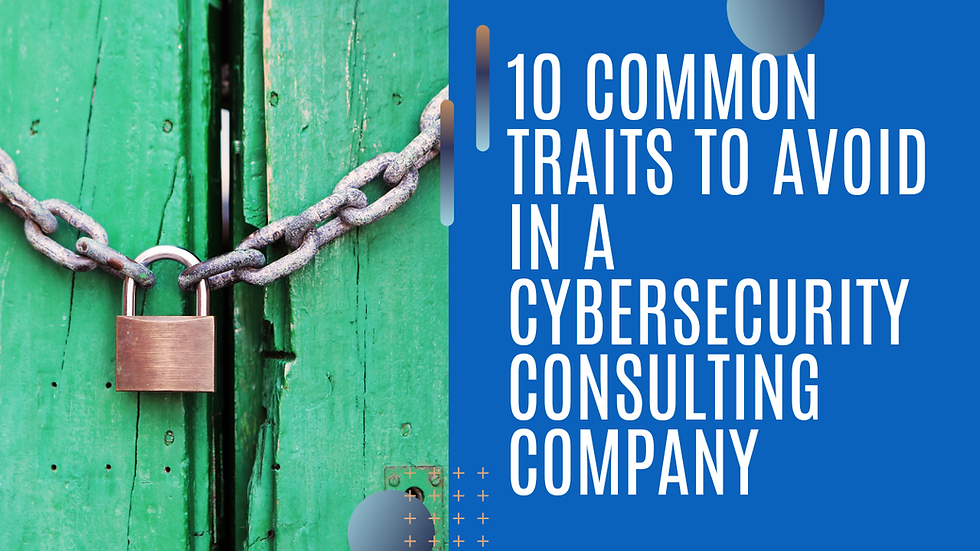10 STEPS TO MATURE YOUR CYBER SECURITY PROGRAM
- Chris Odom
- Jun 20, 2020
- 5 min read
Updated: Jan 19, 2024
10 Steps To Mature your Cyber Security Program
Cyber security is a crucial part of your success as an organization. Protecting your employees and clients involves in-depth and thoughtful processes. There are important steps to take as you work to improve your cyber security processes and systems, and the right partner can help ensure that you are taking the best steps as you work to increase security for your organization. 10 important steps to mature your cyber security program include:
Take an inventory of all of your tech assets. This includes hardware, software, cloud systems, data, and dataflows. Understanding all of the pieces of the puzzle will be key as you work to protect your information and data.
Conduct infosecurity and business risk assessments to determine your current security posture and risk. If you don’t understand your current security situation, you won’t know what you need to do to improve it. It’s important to know what current security measures you are employing, and how much risk your organization can afford to have.
Conduct network vulnerability scans and a penetration test. This helps you understand your exposure and where you need to improve. Understanding your weak areas is key to being able to improve your cyber security plan and platform. A cyber security partner is a critical asset here—they will help run penetration testing to help you see clearly where hackers and professional attackers can get in.
Use your risk assessment to document your desired security state. Understanding how much risk you’re willing to tolerate is critical in establishing a cyber security plan. You need to know your preferred security state in order to be sure you can meet goals and make plans. Some organizations are ok with more risk, while others need the lowest risk possible. It’s entirely up to you.
Document your strategies and tactics by formalizing policies, controls, and procedures. If you don’t write down your plans, it’s unlikely you’ll get what you want in the long run. Having thought-out policies and procedures ensures that your entire organization understands and will adhere to cybersecurity standards.
Understand the results of your risk assessment and what options you have for services. It’s best to choose a partner in cyber security to help you move forward with your security upgrades. Understanding the services they offer will help you know what your options are as you analyze your risk.
Do a gap analysis and prioritize your most pressing initiatives. A gap analysis will help you clearly see where you are missing policies or procedures for cyber security in your organization. Prioritization is critical in determining which areas need to be tackled first as you work to a stronger cyber security system.
Implement your security initiatives. This is another area where a cyber security partner can be helpful. They can help you identify what initiatives you need to take on in your organization and can give you strategies or specific instructions for how to implement them. They also may be able to help implement these policies for you. Implementing security initiatives is key to improving cyber security.
Integrate your projects into your ongoing operations. SecOps, IT ops, and Systems Development Life Cycles (SDLCs) are critical areas where you need to implement these cyber security projects. Every area of your organization can likely benefit from improved cyber security, so once you understand the initiatives you need to tackle, implement them everywhere you can.
Continuously improve. Yearly updates to all of your inventory and policies are key to keep an up-to-date picture of the effectiveness of your cyber security program. Regular analysis, improvement, updates, etc. are key to effective cyber security.

The 3 Phases of Cyber Security Maturity
Emagined™ uses a simple, easy-to-follow process to address security program creation and maturity in the form of our proprietary methodology to walk individuals through all of these key processes. There are three high-level phases to building and maturing your cyber security program:
Current State: Knowing your current security posture.
Target State: Defining your desired (and required) security posture.
Integrate: Bridging the gaps between your current and target state to get the biggest return on your security efforts.
We have found there is a “clear path,” a best way of doing things and an order and organizational aspect that maximizes the impact of your security efforts. With over 1,000 projects across 57 industries, it just works!
Think about this for a moment:
What if you could eliminate all the stress and frustration that comes with maturing your security program?
What if you could do it knowing every day what you’re going to be working on and how you’re going to go about it?
What would it mean to your business to have a step-by-step strategy that’s calibrated or customized to exactly what matters to your business. That means, no more management by compliance.
What would it mean to you if you could get five or ten times the results from your security efforts and security budget?
WHY EMAGINED? THE EMAGINED™ SIGNATURE SOLUTION
The Emagined™ Signature Solution is a three-phase, nine-step process to encourage a different way of approaching cybersecurity. Many executives, managers, and security professionals ask themselves, “Is my organization secure?” or “Is my organization compliant?” The hope is that somehow they can scan through a list of requirements, check all the boxes, and then feel at peace about their security exposure. But how can we measure whether or not all of those checked boxes equate to meaningful security?
Instead, we encourage those responsible for cybersecurity to ask:
“Is my cybersecurity program effective?” OR
“Do my security efforts meet the risk requirements of the organization?”
This is where Emagined™ diverges from so many other security companies when evaluating HOW to mature an organization’s security program. We promote a bottom-up approach (proactive) as opposed to a top-down (reactive) compliance-driven approach. This is an important concept because it’s a holistic approach as opposed to implementing one-off countermeasures to address individual compliance concerns.
If you want to mature your security program, you need a clear understanding of where you’re starting. You also must have a clear understanding of your ideal target security state. First, inventory everything you already have in place. Next, establish where it is that you need to be, then build the RIGHT level of security based on optimized security standards dictated by necessary risk-based capabilities.
Simple, right? But, simple doesn’t mean easy.
Cybersecurity isn’t a closed loop with a determined finish line. Cybersecurity is a culture and something to be done every day. Attackers have unlimited time and need only exploit one vulnerability to undo months or years of work. And it takes a lot of work to make sure we can sleep at night knowing we are doing everything we can (within our given resource constraints) to provide our organizations with the most effective and efficient security possible.
If you’re ready to step up and mature your cyber security program, follow the steps and partner with Emagined Security to create the cyber security program your organization needs.
.png)


